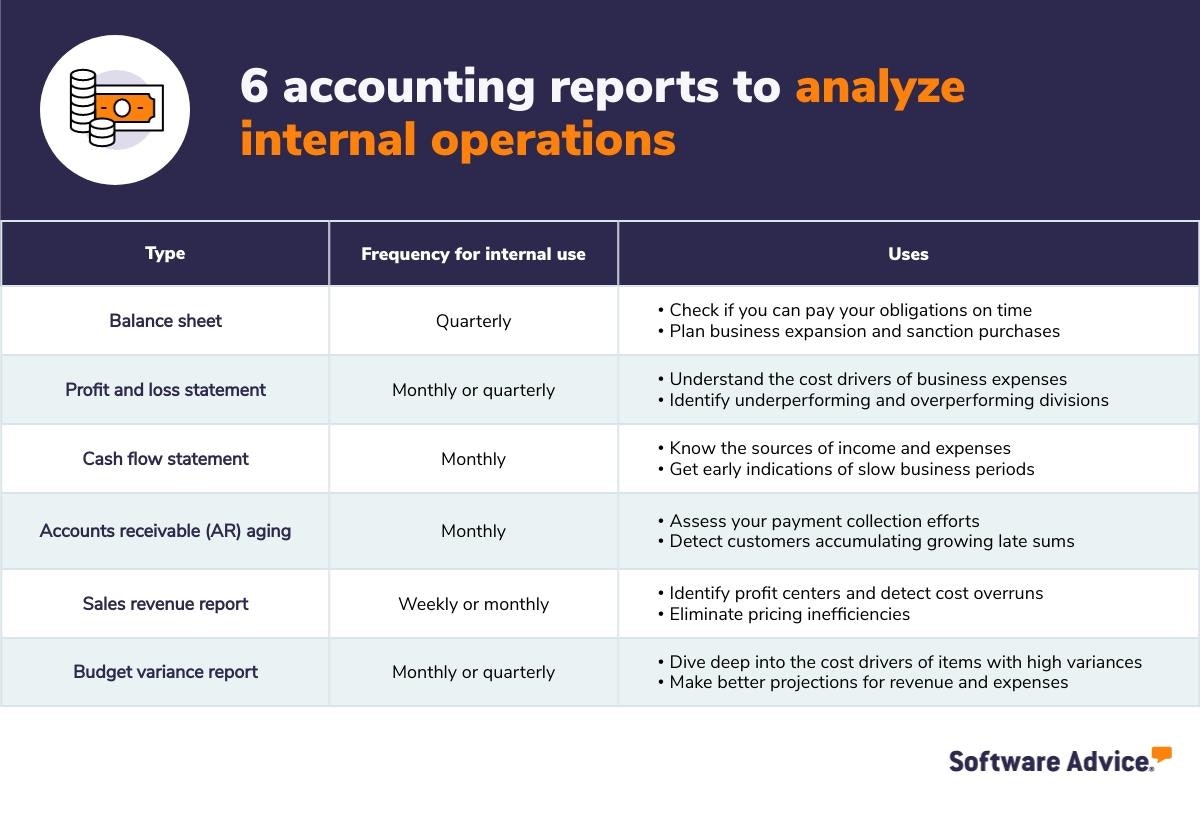6 Accounting Reports To Analyze Your Small-Business Operations
Small businesses are quite mindful of creating annual financial reports, mainly for the purposes of filing (and saving) taxes and informing investors about company performance. But using these reports for internal decision-making is often overlooked.
There are more than 30 million small businesses in the U.S.[1], and a vast majority of them have less than 60 days of cash on hand.[2] That’s not just bad luck; that’s neglected financial management.
A critical task small business owners and managers should prioritize from day one is introducing accounting reports that explain what exactly is happening in their business. This requires going beyond standard financial reporting. And while this isn’t compulsory, if you’re serious about growing and scaling your business, it’s the key. Regularly analyzing your business data can help improve decision-making and streamline operations.
If you’re a small business owner or staff accountant, this article is for you. We discuss six accounting reports that are absolutely essential to analyze your business operations. Etch these in your day-to-day decision-making for sound financial health.
In this article, we’ll cover:
6 key reports to publish for better management
Ideal tech stack to easily create accounting reports
What are accounting reports?
Accounting reports are financial statements that compile a business’s financial activities over time to indicate how well the business is performing. These reports can be as brief or as detailed as required. For example, a concise report on the overall profits or a detailed report on the sales of a new product line analyzed by region.
Accounting reports are primarily created for audit and tax purposes, but they can also be used in decision-making by business owners and department managers. Preparing financial reports for managers means going into more detail to provide a thorough performance assessment of business operations.
Urina Harrell[3], a marketing consultant for small businesses and nonprofits, says successful firms regularly prepare financial reports for managers, but there are those for whom managerial reporting is an afterthought.

“Lack of managerial reporting becomes a breeding ground for poor decision making. Many SMBs don’t understand their margins, and if they do it’s at a very low level. They know how much it costs to make a product, but they don’t factor in labor costs, capacity restraints, inventory turn rates, etc. It’s not that business owners don’t care about managerial accounting, it’s that they don’t have the time capacity.”
Urina Harrell
6 accounting reports to publish for better management
Keep a close eye on these six accounting reports to ensure a good grip on your business’s financial health. In the next section, we discuss these reports in detail.

Balance sheet
Managing your business’s finances begins with understanding what you own (assets) and what you owe (liabilities), and a balance sheet summarizes that information. In a perfect world, you want your assets to always exceed your liabilities, ensuring you have enough money to pay off debts and run operations.
Who are its main users? Business owners, middle managers, investors, lenders
How often to publish for internal use? Quarterly
Why use it? To check if you can pay your obligations on time, plan business expansion, and sanction new projects or purchases.
How to add value when presenting findings: Compare the results with industry averages and with data from the previous accounting period (quarterly, yearly, etc.).
What you should look for:
Cash: It shows the money your business has, including cash on hand and in bank account deposits.
Net working capital: It measures the money you have to run daily business operations after deducting all that you owe to your suppliers or lenders. It’s calculated by subtracting the amount you must pay within a year (current liabilities) from the resources that will convert into cash within a year (current assets).
Profit and loss statement
Profit and loss (P&L) statement—also called the income statement—answers the question that dominates most managers’ minds at the end of every month or quarter: How did we do? It shows whether you made a profit or incurred a loss.
Remember, laying off employees to slash expenses is not always the way to recover from a loss, just as you don’t always increase budgets across the board upon earning profits.
Who are its main users? Business owners, middle managers, investors, lenders
How often to publish for internal use? Monthly or quarterly
Why use it? To understand the nature of business expenses and measure the commission earned by teams from profits on sales.
How to add value when presenting findings: Compare your profit with industry averages. Showcase trends in revenue and expenses over time. Break down expenses into the components that constitute them—for instance, salaries into the number of employees, benefits, etc. Compare net profit by products or services. Highlight underperforming and overperforming divisions.
What you should look for:
Gross profit (or gross margin): It shows the profit earned before considering any expenses besides what went into producing the product.
Operating profit: It shows the profit left after deducting operating expenses such as employees’ salaries and advertising costs from the gross profit.
Net profit: It shows the final profit left over after including extra income (from interest) and deducting other expenses (taxes) from the operating profit. It’s shown at the bottom of the P&L statement, so it’s also called the “bottom line” of a company’s net income.
Cash flow analysis statement
Your financial condition may seem good on a balance sheet with a stockpile of goods in your warehouse, but unless you have cash in the business, you’ll find it difficult to run routine business activities.
On your income statement, you may have significant profits, but profits don’t equal cash flow. It’s good to have profits in your business, but without it, you can still jig things around as long as you break even. Without cash, however, you can’t pay your employees and suppliers, or make other investments.
A cash flow statement analyzes your business activities that are only related to cash. It doesn’t involve any noncash transactions, such as sales or purchases made on credit.
Who are its main users? Business owners, middle managers, departmental managers, suppliers
How often to publish for internal use? Monthly
Why use it? To know the sources money comes in from and gets spent on, to understand if your business can survive over the next few months, and to get early indications of slow business periods.
How to add value when presenting findings: Show high and low business seasons, and predict expenses for upcoming months.
What you should look for:
Cash flow from operations: It records the cash used in (or generated from) core business operations, such as manufacturing and selling a product.
Cash flow from investing: It records the cash used in (or generated from) other business investments, such as the purchase of a warehouse or sale of a business division.
Cash flow from financing: It records the cash used in (or generated from) shares and loans, such as the interest on a bank loan or share of profits paid to investors.
Accounts receivable aging
Completing sales and sending out invoices is just one part of the fight for your small business. Another is to make sure payments are made and collected on time.
Accounts receivable (AR) lists the sales made by extending credit to customers and indicates the amount to be collected in the near term. The success of your business can be attributed to great customers who are prompt in paying their dues.
AR aging reports help you watch out for customers who may be facing financial difficulties in payments but are likely to pay as well as those who may not be able to pay you at all.
Who are its main users? Business owners, middle managers, departmental managers, team leads
How often to publish for internal use? Monthly
Why use it? To assess your payment collection efforts, and to identify customers that have accumulated significant late sums, those that have recently begun to delay payments, and those who always pay on time.
How to add value when presenting findings? Produce the AR aging report by the duration of overdue, salesperson, and product. Analyze the late payment history of high-value accounts.
What you should look for:
Total sales per AR account: It indicates the sales made to every customer on credit.
Outstanding amount per account: It shows the amount due to be paid by a customer as of the report creation date.
Outstanding amount overdue by number of days: It dissects the amount overdue by the number of days. It can be divided as overdue by 30 days, over 30 days, 60 days, and so on.
Sales revenue report
As a small business owner, it’s crucial to analyze each product and service to see if it’s advancing your business. A sales report details how much of your sales revenue comes from which sources.
For instance, an eCommerce business that sells superhero coffee mugs, t-shirts, backpacks, and other products will have different pricing and sales quantity for each product. A sales revenue report will dig into the revenue of each product as well as identify the highest revenue contributor to determine if you’re moving toward your revenue goals.
Who are its main users? Business owners, middle managers, departmental managers, team leads
How often to publish for internal use? Weekly or monthly
Why use it? To identify profit centers of your business, detect cost overruns on any projects or products, and eliminate pricing inefficiencies.
How to add value when presenting findings: Compare changes in the units sold for different products. Track changes in the price of a product or service over time. Compare the sales revenue of different products and services over historical accounting periods (break it down further by store, location, product, etc.).
What you should look for:
Net sales revenue by product: It shows the income earned on a product line after deducting any discounts.
Variable operating costs by product: It records the costs incurred on a product line for packaging, shipping, and delivery.
Product costs: It records the losses incurred due to the damage or loss of products.
Product margin: It shows the profit on a product line. It’s calculated by subtracting the costs of a product line (variable and product costs mentioned above) from its net sales revenue.
Budget variance report
Another aspect vital for your business is budgeting and forecasting. A budget specifies how much cash you will spend on purchases or investments over the next month, quarter, or year. These expenses are usually decided based on revenue forecasts—i.e., the earnings or profits you expect from different product lines and departments.
Variance reports are nothing more than taking a look at the budgeted expenses or forecasted revenues and comparing them to the actual results. They show how much the actual values differ from the budgeted or forecasted figures.
Who are its main users? Business owners, middle managers, departmental managers, team leads
How often to publish for internal use? Monthly or quarterly
Why use it? To determine the productivity of teams, control cost overruns, and make better projections for revenue and expenses.
How to add value when presenting findings: Generate variance reports by department. Dive deep into the cost drivers of items with high variances. Compare variances from previous fiscal years or periods. Make budgeting suggestions for the upcoming period.
What you should look for:
Variance in sales revenue: It’s the difference between the forecasted sales and actual sales. A positive variance in sales revenue is an unfavorable outcome, indicating your business sold less than expected.
Variance in expenses: It’s the difference between the budgeted costs and actual costs. A positive variance is a favorable outcome, indicating your business spent less than it stipulated.
Variance in net profit: It represents the difference in the projected profits and actual profits. A positive variance is an unfavorable outcome, indicating your business earned less than expected.
Benjamin Wann[4], CPA, CMA, and a specialist in management accounting, says choosing the most important internal financial statement depends on your business type.

“Month-to-month detailed P&L and sales statements are important for all businesses. Further than that, it’s good to ask which aspect of your business consumes most profits. If you’re in the retail industry selling fast-moving consumer goods, you might want to keep a check on inventory reports. For companies in the SaaS business, details from IT and marketing departments will be extremely important.”
Benjamin Wann
Here’s a quick video we created on some tips to prepare managerial reports:
Ideal tech stack to easily create accounting reports
Business management is a never-ending task, and keeping pace with the changes can be difficult without technology. Support your accounting practice with these technology tools, and ensure strong management reporting.
Data collection: Identify the software platforms your business already uses to record data, such as payroll which stores employee information, ERP which links several business functions, and inventory management which is used to manage the purchase and storage of inventory. Use these data sources to get an in-depth breakdown of revenue and expenses (e.g., spend on subcontractors) and up-to-date information in real time.
Bookkeeping: Use bookkeeping or accounting software to easily track your expenses and unpaid invoices, automate the generation of financial statements, and simplify routine accounting activities. The software helps maintain accurate records with less effort and time.
Report presentation: Use business intelligence or financial reporting software to publish accounting reports in a couple of clicks. Use financial dashboards to present findings in an appealing manner and customize the information for end users.
Communication: Use team communication software to distribute your reports, communicate with relevant stakeholders in separate groups, and take feedback.
Sources
Advocacy Releases 2021 Small Business Profiles For The States, Office of Advocacy, U.S. Small Business Administration
A Way Forward for Small Businesses, Harvard Business Review
Urina Harrell, LinkedIn
Benjamin Wann, LinkedIn